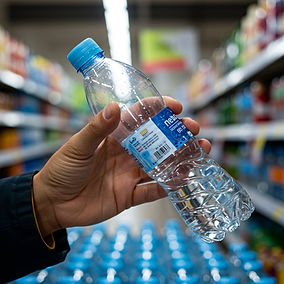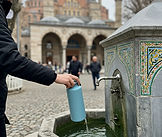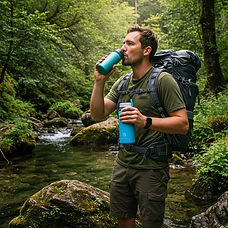Drinking Tap Water Safety Worldwide
Your Essential Guide to Drinking Water Safety for International Travelers
Drinking water safety: Summary for Quick Reference
-
Drinking water safety varies significantly by country and region. Always research your destination.
-
Tap water is generally safe in developed countries but may not be potable everywhere.
-
Bottled water is a common alternative, but always check the seal.
-
Water purification methods (filters, tablets, boiling) are crucial for uncertain sources.
-
Dehydration is a major risk when traveling; prioritize consistent hydration from safe sources.

Tap Water, Bottled Water, and Purification Methods Worldwide
The excitement of planning an international adventure often focuses on new experiences and cultural immersion. Yet, amidst the anticipation, one fundamental aspect of health preparedness is often overlooked: drinking water safety. An unexpected illness from contaminated water can quickly turn a dream trip into a stressful ordeal. This comprehensive guide provides travelers with essential "water wisdom," navigating global variations and offering practical tips for staying hydrated safely throughout your international adventures.

Drinking Water Safety: Essential FAQ
1. Is tap water safe to drink everywhere in the world?
No. Tap water safety varies widely by country and even by region within a country. Always research your specific destination's water quality and heed local advice.
2. How can I check if tap water is safe in my destination?
Consult official government travel advisories (e.g., CDC, WHO), ask your hotel staff or local residents, and look for signs indicating "potable" water. Many cities also have online resources for water quality.
3. What are the risks of drinking unsafe water?
Drinking contaminated water can lead to various illnesses, most commonly traveler's diarrhea, but also more serious infections like cholera, typhoid, or giardiasis.
4. Should I avoid ice cubes abroad?
In areas where tap water is not safe to drink, you should also avoid ice cubes, as they are likely made from the same unsafe water. Stick to bottled beverages without ice.
5. Is bottled water always safe?
Bottled water is generally safe, but always check that the seal is intact before purchasing. Refilled bottles are a risk, especially in areas with poor sanitation.
6. What are portable water filters or purification tablets?
These are devices or chemicals that can make unsafe water potable. Portable filters remove bacteria and protozoa, while purification tablets kill bacteria and viruses. They are essential for travel to remote areas or places with unreliable water sources.
7. Can I get sick from brushing my teeth with tap water?
If the tap water is not safe for drinking, it's also not safe for brushing your teeth. Use bottled or purified water for oral hygiene in such regions.
8. How much water should I drink daily when traveling?
Aim for at least 8 glasses (about 2 liters) of safe water daily, and more if you are physically active, in a hot climate, or experiencing diarrhea.
9. What are oral rehydration salts (ORS) and why are they important for waterborne illness?
ORS are packets of salts and sugars that, when mixed with clean water, help your body quickly rehydrate and replenish electrolytes lost due to severe diarrhea or vomiting. They are crucial for preventing dehydration during illness.
10. How can I tell if a public fountain is safe to drink from?
Only drink from public fountains that are clearly marked "acqua potabile" (potable water) or have a universal drinking water symbol. If there's no clear indication, it's safer to avoid it.
1. The Bottom Line: Water Safety Varies Globally
While many developed nations boast tap water that is consistently safe and adheres to stringent international standards, it's crucial to understand that water quality is not universal. What's safe to drink in one country may not be in another. Organizations like the World Health Organization (WHO) set global guidelines, but local infrastructure, geological factors, and sanitation practices all play a role in the actual potability of tap water. Always research your specific destination's water safety recommendations before you travel.
2. Understanding Regional Variations in Water Quality and Taste
Even within countries, and certainly across different regions of the world, tap water can vary significantly in taste, odor, and mineral content. These differences are primarily due to diverse geological landscapes, water sources (e.g., alpine springs, groundwater, desalinated sea water), and local treatment methods.
-
Mineral Content ("Hardness"): Water can be "soft" (low mineral content) or "hard" (high mineral content, particularly calcium and magnesium). Hard water might have a more pronounced taste and can leave mineral deposits, but it is generally safe to drink.
-
Source Variations: Water sourced from deep underground aquifers might taste different from water sourced from surface rivers or lakes, even if both are treated to be safe.
-
Local Treatment: Different purification processes can subtly alter taste. Some regions might use more chlorine, which can be noticeable.
These variations are usually harmless but can be surprising if you're not used to them. Don't be alarmed by a different taste; it doesn't necessarily indicate unsafe water.
3. Navigating Drinking Water Sources: A Practical Guide for Travelers
Staying hydrated is paramount to enjoying your international adventure. Here's how to evaluate different water sources:
-
Tap Water in Your Accommodation & Restaurants:
-
Generally Your Safest Bet (in developed nations): Tap water in hotels, restaurants, and homes in many developed countries is typically safe due to adherence to national and international standards.
-
When in Doubt, Just Ask: If you're unsure, a simple question like "Is the tap water potable?" (or its equivalent in the local language) to your server or hotel staff will provide reassurance.
-
-
Public Fountains & Water Dispensers:
-
A Traveler's Friend (when marked safe): Many cities worldwide offer public drinking fountains or water refill stations. These can be a refreshing and eco-friendly way to hydrate.
-
Proceed with Caution: Only drink from public sources explicitly marked as "potable" (drinking water). Avoid those that look stagnant or are in poorly maintained areas.
-
-
Natural Springs & Untreated Sources: Proceed with Extreme Caution:
-
High Risk of Contamination: Unless explicitly marked as safe by local authorities with visible testing information, avoid drinking directly from natural springs, rivers, lakes, or wells. They can harbor harmful bacteria, viruses, and parasites.
-
Boil or Purify if Necessary: In remote areas or emergency situations, boil untreated water vigorously for at least one minute (longer at higher altitudes) or use a reliable portable water filter or purification tablets.
-
-
Bottled Water: Convenience at a Cost (Environmental and Monetary):
-
Ubiquitous Availability: Bottled water is sold almost everywhere globally. "Still" and "sparkling" options are common.
-
Check the Seal: Always ensure the bottle is properly sealed before purchasing to avoid refilled bottles.
-
Consider the Planet: Opt for refilling a reusable bottle from safe tap water sources or well-maintained public fountains whenever possible to reduce plastic waste.
-
-
4. Smart Hydration Tips for Your Trip
-
Carry a Reusable Water Bottle: This allows you to easily refill throughout the day from safe sources.
-
Don't Be Afraid to Ask: In restaurants, you can often request "tap water" instead of bottled water.
-
Stay Hydrated, Especially in Warm Climates: Drink water regularly, especially during outdoor activities or in hot weather.
-
Observe Locals: You'll often see locals refilling their bottles at public fountains or drinking tap water, which can be a good indicator of local trust in water quality.
-
Be Prepared for Emergencies: Always have a backup plan for water, especially if traveling to rural or less developed areas.
Key Sources of Information:
-
World Health Organization (WHO): Provides global guidelines and recommendations for drinking water quality and safety.
-
Centers for Disease Control and Prevention (CDC): Offers detailed country-specific health recommendations, including water safety.
-
National Environmental Agencies (e.g., EPA in the US, European Environment Agency): Provide regional and national water quality reports.
-
Reputable Travel Health Clinics: Offer expert advice on water safety tailored to your itinerary.
-
Academic and Scientific Journals: For in-depth research on waterborne diseases and purification technologies.

